Business Model as a Base for Building Firms’ Competitiveness
Abstract
1. Introduction
2. Business Model—Theoretical Perspective
2.1. Elements of the Business Model
2.2. Creating and Innovating a Business Model
- Mobilization,
- Understanding,
- Designing,
- Implementation, and
- Managing [2].
- to satisfy existing but unanswered market needs,
- to bring new technologies, products, or services to market,
- to improve an existing market, or
- to create an entirely new market [2].
2.3. From Business Model to Competitive Advantage
- How do small ICT firms create their business models?
- What are the crucial elements of the business model of the small ICT firms on which the firms base their sustainable competitive advantage?
3. Materials and Methods
3.1. Defining the Sample
- sample is not selected based on statistical probability, but on other theoretical or purposive sampling criteria,
- samples are small, but studied intensively,
- selection of the samples is sequential,
- sample selection is conceptually driven,
- there needs to be rationale about the case selection, and
- qualitative samples provide analytic generalizations, but not statistic generalization [33].
3.2. Defining the Framework
- Value proposition: degree of customization of the service (from standardized offer to fully customized);
- Customer segments: complexity of the market according to the location of the customers (from local market to a higher degree of internationalization);
- Channels: complexity according to the number of steps to deliver service from the firm to the customer (from direct sale to several intermediaries);
- Customer relationships: degree of personalization for each customer (from no personalization to distinctively personalized approach to customers);
- Key activities: scope of the activities (from one basic activity to broad scope of activities of the business);
- Key resources: complexity of the main resources (from financial resources as the elementary resource to organizational as composite resource);
- Key partnerships: degree of reliance on the partners outside of the firm (from occasional collaboration to complex networks of partnerships and open networks);
- Cost structure: complexity of the business costs (from fixed costs to more complex structures); and
- Revenue streams: complexity of business revenues (from simple service sale to additional services).
4. Creating a Successful Business Model in the ICT Industry—Case Study
4.1. Case 1 Overview
4.2. Case 2 Overview
4.3. Case 3 Overview
5. Discussion
- channels,
- key resources,
- cost structure, and
- revenue streams.
- value propositions,
- customer segments,
- customer relationships,
- key activities, and
- key partnerships.
6. Conclusions
Author Contributions
Funding
Conflicts of Interest
References
- Morris, M.; Schindehutte, M.; Richardson, J.; Allen, J. Is the business model a useful strategic concept? Conceptual, theoretical, and empirical insights. J. Small Bus. Strategy 2006, 17, 27–50. [Google Scholar]
- Osterwalder, A.; Pigneur, Y. Stvaranje Poslovnih Modela; Školska knjiga: Zagreb, Croatia, 2014. [Google Scholar]
- Morris, M.; Schindehutte, M.; Allen, J. The entrepreneur’s business model: Toward a unified perspective. J. Bus Res. 2005, 58, 726–735. [Google Scholar] [CrossRef]
- Zott, C.; Amit, R.; Massa, L. The business model: Recent developments and future research. J. Manag. 2011, 37, 1019–1042. [Google Scholar]
- Wirtz, B.W.; Pistoia, A.; Ullrich, S.; Göttel, V. Business models: Origin, development and future research perspectives. Long Range Plan. 2016, 49, 36–54. [Google Scholar] [CrossRef]
- Saleem, F.; Fakieh, B. Enterprise Architecture and Organizational Benefits: A Case study. Sustainability 2020, 12, 8237. [Google Scholar] [CrossRef]
- Mendelson, H. Organizational architecture and success in the information technology industry. Manag. Sci. 2000, 46, 513–529. [Google Scholar] [CrossRef]
- Baden-Fuller, C.; Morgan, M.S. Business models as models. Long Range Plan. 2010, 43, 156–171. [Google Scholar] [CrossRef]
- European Commision. Annual Report on European SMEs 2016/2017. Available online: https://op.europa.eu/en/publication-detail/-/publication/0b7b64b6-ca80-11e7-8e69-01aa75ed71a1/language-en/format-PDF (accessed on 29 October 2020).
- Barringer, B.R.; Ireland, R.D. Poduzetništvo–Uspješno Pokretanje novih Poduhvata, 3rd ed.; OFF-SET: Tuzla, Bosnia and Herzegovina, 2010. [Google Scholar]
- Teece, D.J. Business models, business strategy and innovation. Long Range Plan. 2010, 43, 172–194. [Google Scholar] [CrossRef]
- Andreini, D.; Bettinelli, C. Business model innovation: From systematic literature review to future research directions. J. Manag. Gov. 2017, 21, 785–792. [Google Scholar]
- Johnson, M.W.; Christensen, C.M.; Kagermann, H. Reinventing your business model. Harv. Bus Rev. 2008, 86, 57–68. [Google Scholar]
- Shi, Y.; Manning, T. Understanding business models and business model risks. J. Priv. Equity 2009, 12, 49–59. [Google Scholar] [CrossRef]
- Vives, L.; Svejenova, S. To, from and beyond the margins: Business models: Towards an integrative framework. Manag. Res. J. Iberoam. Acad. Manag. 2011, 9, 230–242. [Google Scholar] [CrossRef]
- Giesen, E.; Riddleberger, E.; Christner, R.; Bell, R. When and how to innovate your business model. Strateg. Lead. 2010, 38, 17–26. [Google Scholar] [CrossRef]
- Mitchell, D.; Coles, C. The ultimate competitive advantage of continuing business model innovation. J. Bus. Strateg. 2003, 24, 15–21. [Google Scholar] [CrossRef]
- Malhotra, Y. Knowledge management and new organization forms: A framework for business model innovation. Inf. Resour. Manag. J. 2000, 13, 5–14. [Google Scholar] [CrossRef]
- Wirtz, B.W.; Gottel, V.; Daiser, P. Business model innovation: Development, concept and future research Directions. J. Bus. Models 2016, 4, 1–28. [Google Scholar]
- Dru, J.M. Disruption: Overturning Conventions and Shaking up the Marketplace; John Wiley & Sons: San Francisco, CA, USA, 1996. [Google Scholar]
- Keiningham, T.; Aksoy, L.; Bruce, H.L.; Cadet, F.; Clennell, N.; Hodgkinson, I.R.; Kearney, T. Customer experience driven business model innovation. J. Bus. Res. 2020, 116, 431–440. [Google Scholar] [CrossRef]
- Bocken, N.; Snihur, Y. Lean startup and the business model: Experimenting for novelty and impact. Long Range Plan. 2020, 53, 1019–1053. [Google Scholar] [CrossRef]
- Evans, S.; Vladimirova, D.; Holgado, M.; Van Fossen, K.; Yang, M.; Silva, E.A.; Barlow, C.Y. Business model innovation for sustainability: Towards a unified perspective for creation of sustainable business models. Bus. Strateg. Environ. 2017, 26, 597–608. [Google Scholar] [CrossRef]
- Bocken, N.M.P.; Schuit, C.S.C.; Kraaijenhagen, C. Experimenting with a circular business model: Lessons from eight cases. Environ. Innov. Soc. Transit. 2018, 28, 79–95. [Google Scholar] [CrossRef]
- Pieroni, M.P.; McAloone, T.C.; Pigosso, D.C. Business model innovation for circular economy and sustainability: A review of approaches. J. Clean Prod. 2019, 215, 198–216. [Google Scholar] [CrossRef]
- Massa, L.; Tucci, C.L.; Afuah, A. A critical assessment of business model research. Acad. Manag. Ann. 2017, 11, 73–104. [Google Scholar] [CrossRef]
- Baden-Fuller, C.; Mangematin, V. Business models: A challenging agenda. Strateg. Organ. 2013, 11, 418–427. [Google Scholar] [CrossRef]
- Porter, M.E. Competitive Advantage: Creating and Sustaining Superior Performance; The Free Press: New York, NY, USA, 1998. [Google Scholar]
- Halmi, A. Strategije Kvalitativnih Istraživanja u Primijenjenim Društvenim Znanostima; Naklada Slap: Jastrebarsko, Croatia, 2005. [Google Scholar]
- Eriksson, P.; Kovalainen, A. Qualitative Methods in Business Research: A Practical Guide to Social Research; Sage: London, UK, 2016. [Google Scholar]
- Saunders, M.; Lewis, P.; Thornhill, A. Research Methods for Business Students, 8th ed.; Pearson: London, UK, 2019. [Google Scholar]
- Spiers, L.W. Corporate Governance and its Contribution to Risk and Crisis Management in Small Companies. Ph.D. Thesis, Bournemouth University, Bournemouth, Dorset, UK, 2018. [Google Scholar]
- Curtis, S.; Gesler, W.; Smith, G.; Washburn, S. Approaches to sampling and case selection in qualitative research: Examples in the geography of health. Soc. Sci. Med. 2000, 50, 1001–1014. [Google Scholar] [CrossRef]
- Saunders, M.; Lewis, P.; Thornhill, A. Research Methods for Business Students; Pearson: Essex, UK, 2012. [Google Scholar]
- Seawright, J.; Gerring, J. Case selection techniques in case study research: A menu of qualitative and quantitative options. Polit. Res. Q. 2008, 61, 294–308. [Google Scholar] [CrossRef]
- Maryska, M.; Doucek, P.; Kunstova, R. The importance of ICT sector and ICT university education for the economic development. Procedia Soc. Behav. Sci. 2012, 55, 1060–1068. [Google Scholar] [CrossRef]
- Žitnik, B. Hrvatska IT industrija 1995–2015–2025 nastajanje-stanje-budućnost. OpenInfoTrend. 2015. Available online: http://www.infotrend.hr/files/pdf/casopis/2015/200/InfoTrend-200-special.pdf (accessed on 29 October 2020).
- Amarsy, N. Why and How Organizations Around the World Apply the Business Model Canvas. Available online: http://blog.strategyzer.com/posts/2015/2/9/why-and-how-organizations-around-the-world-apply-the-business-model-canvas (accessed on 29 October 2020).
- Pfeifer, S.; Oberman Peterka, S.; Stanić, M. Business models of micro businesses: Empirical evidence from creative industries. Manag. J. Contemp. Manag. Issues 2017, 22, 1–19. [Google Scholar]
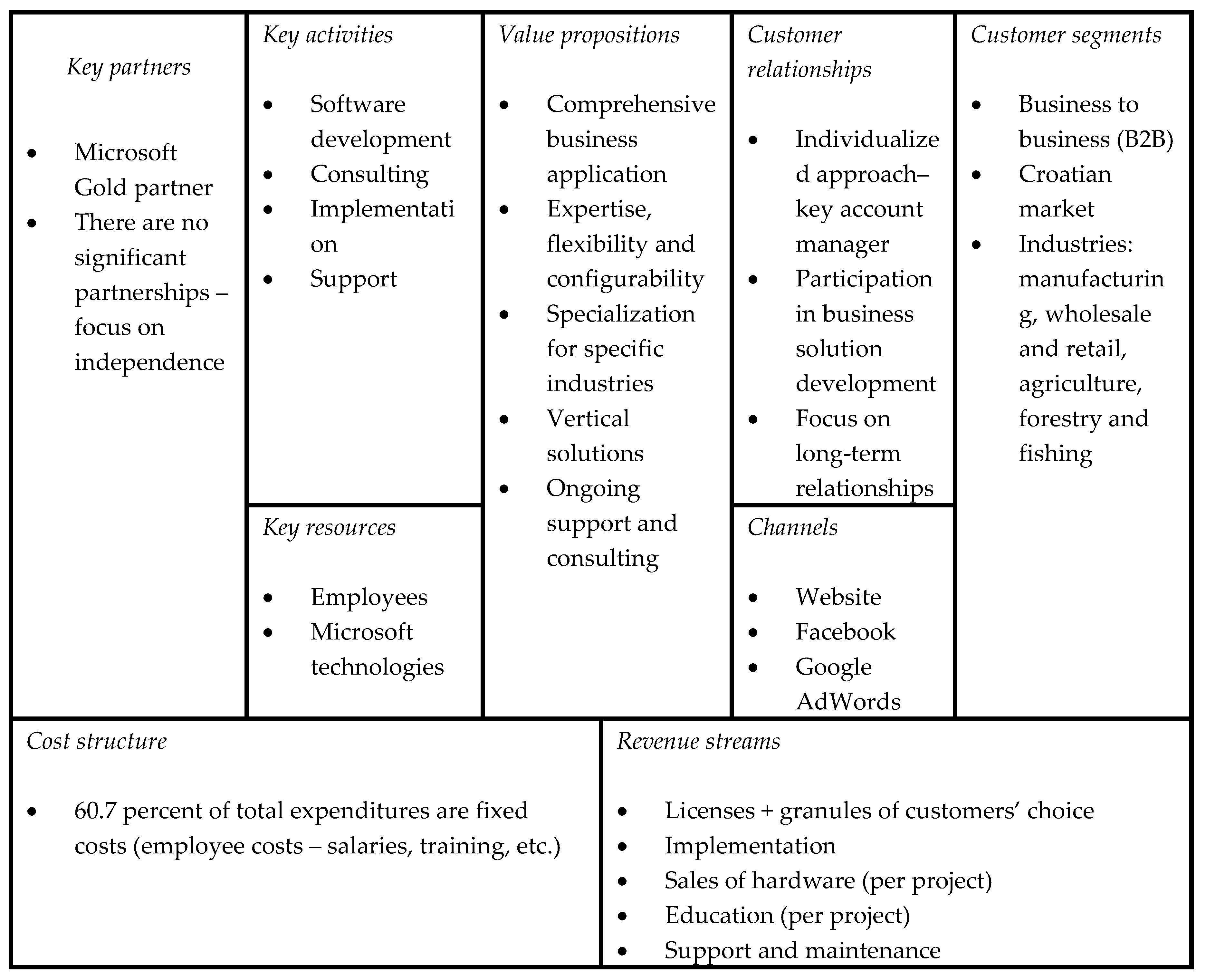
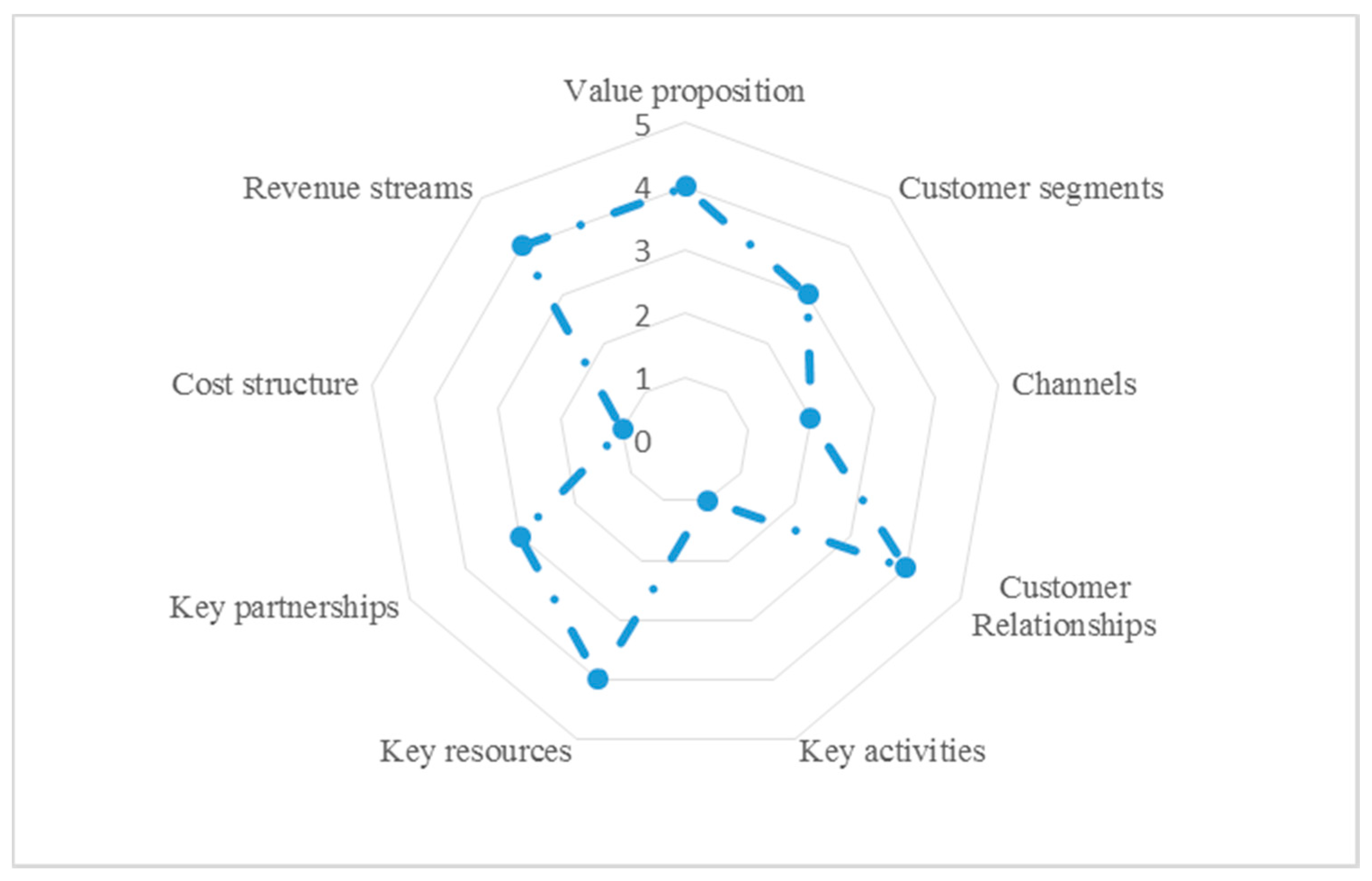
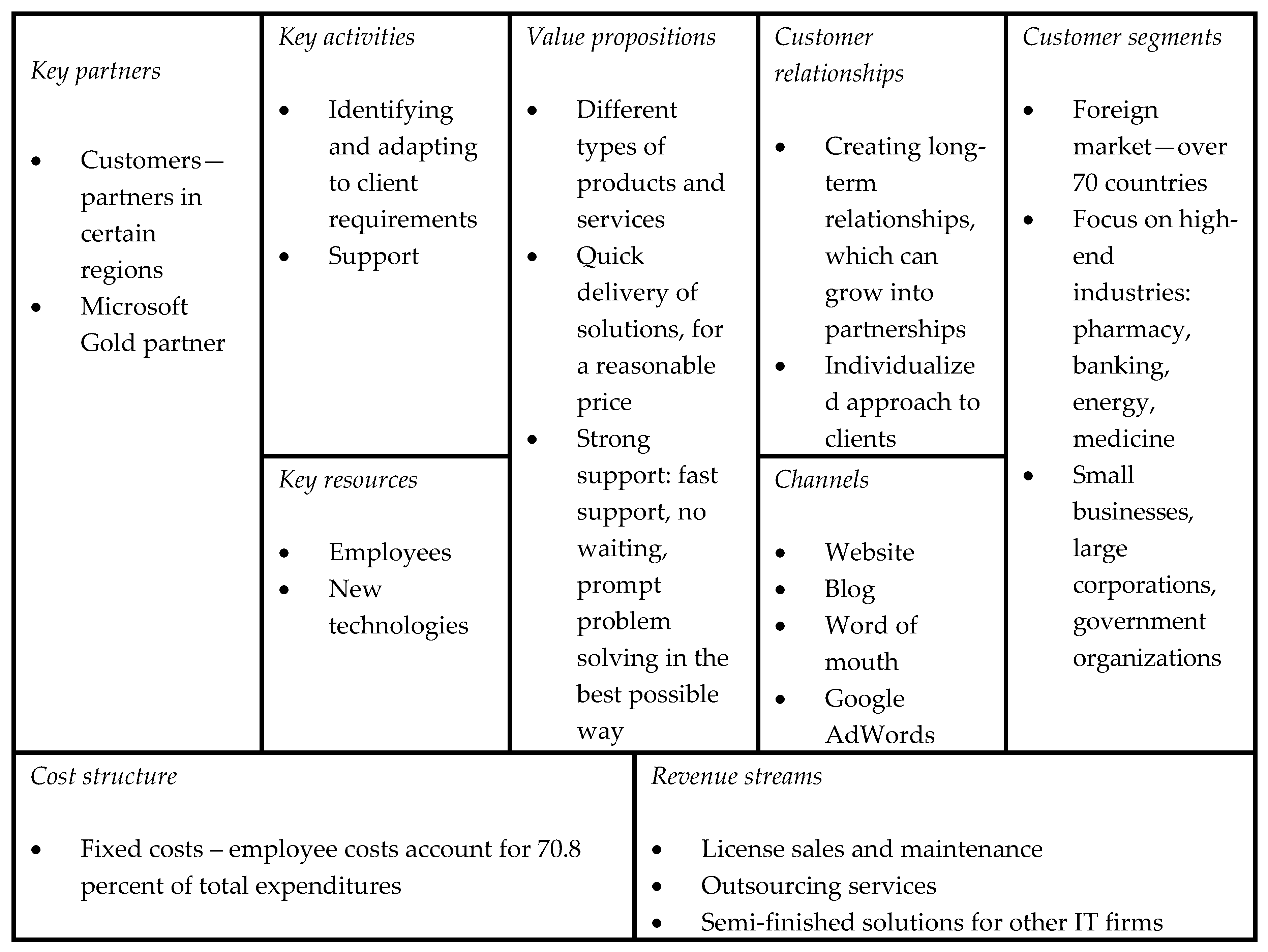
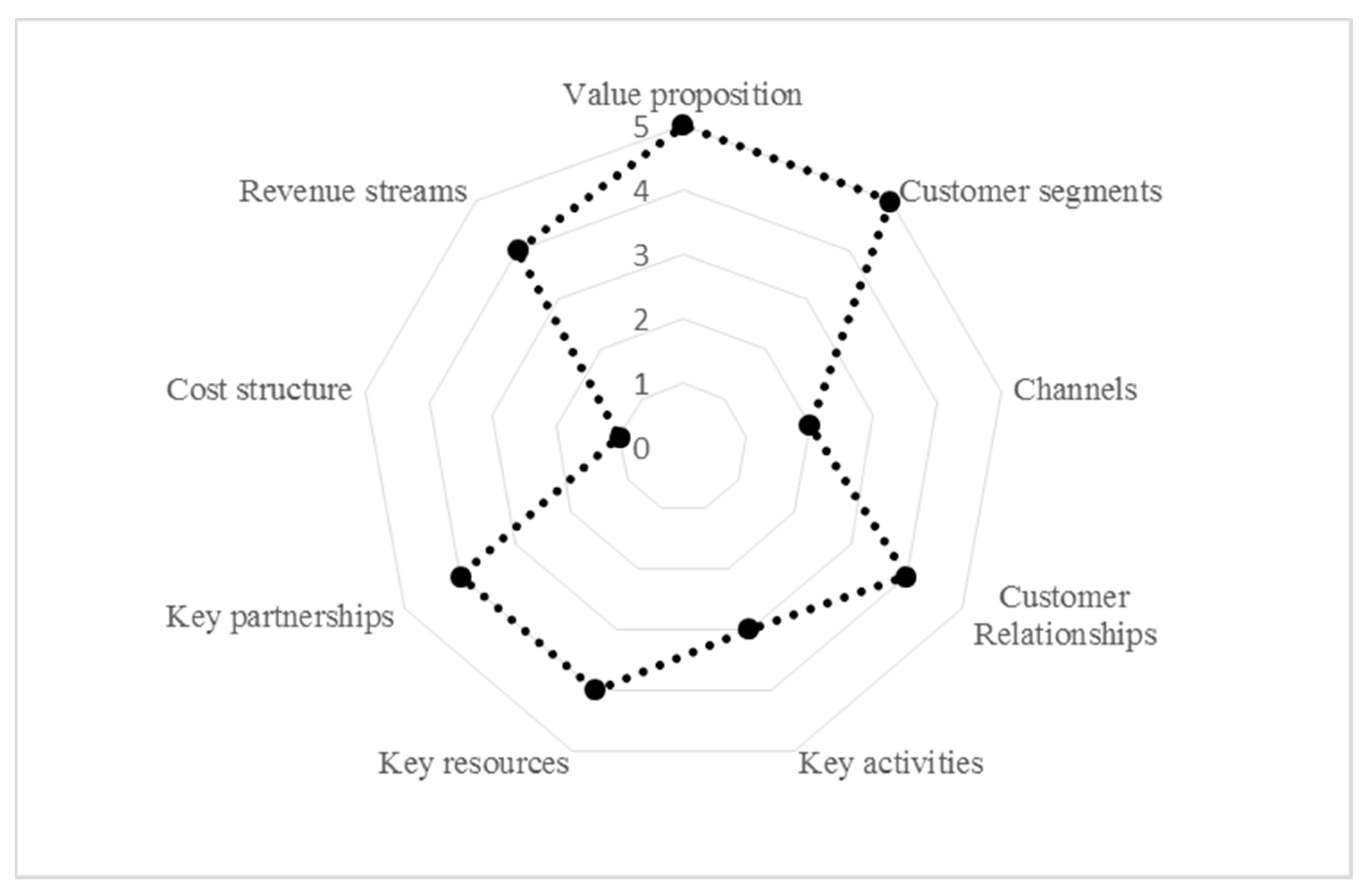
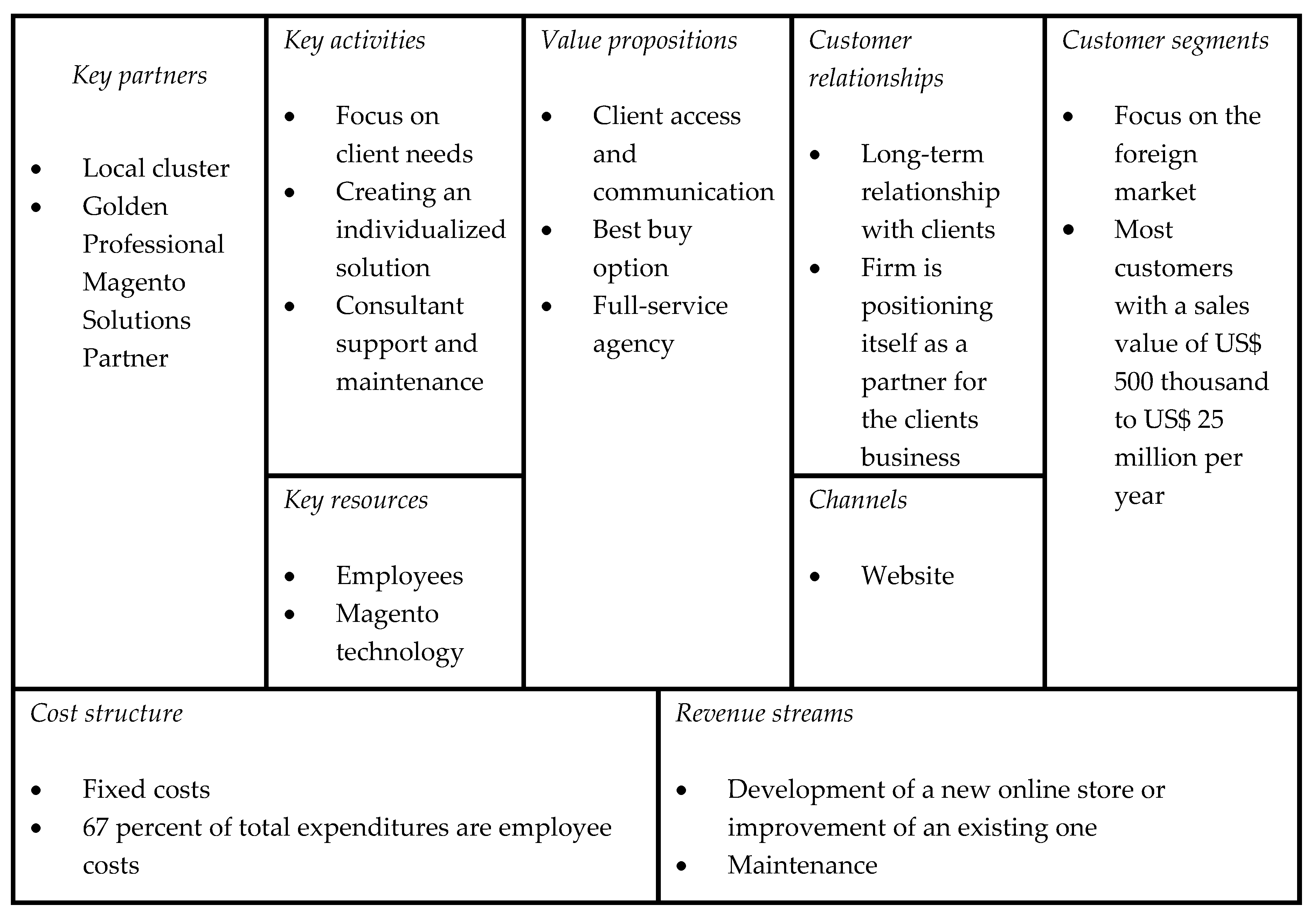
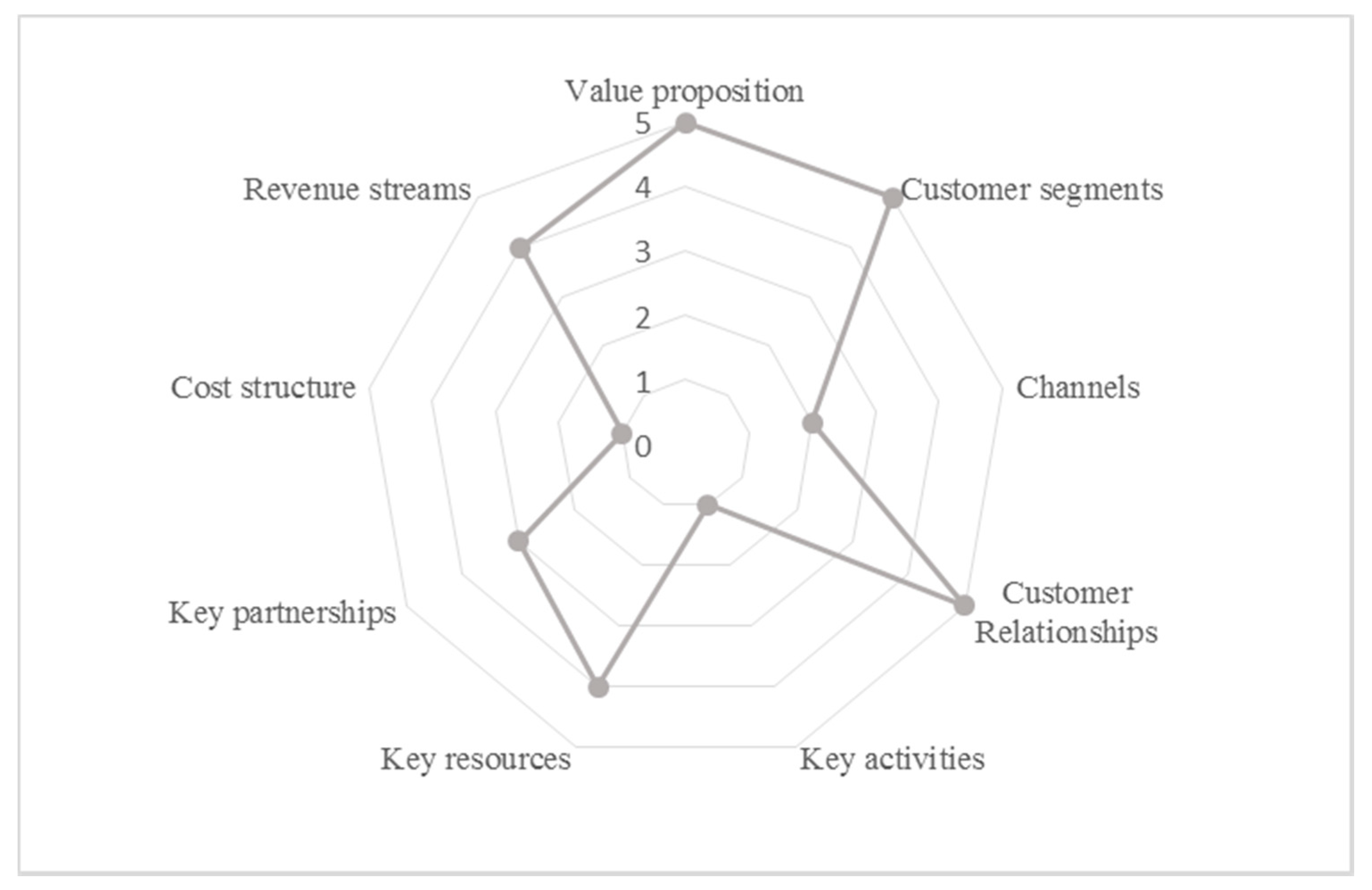
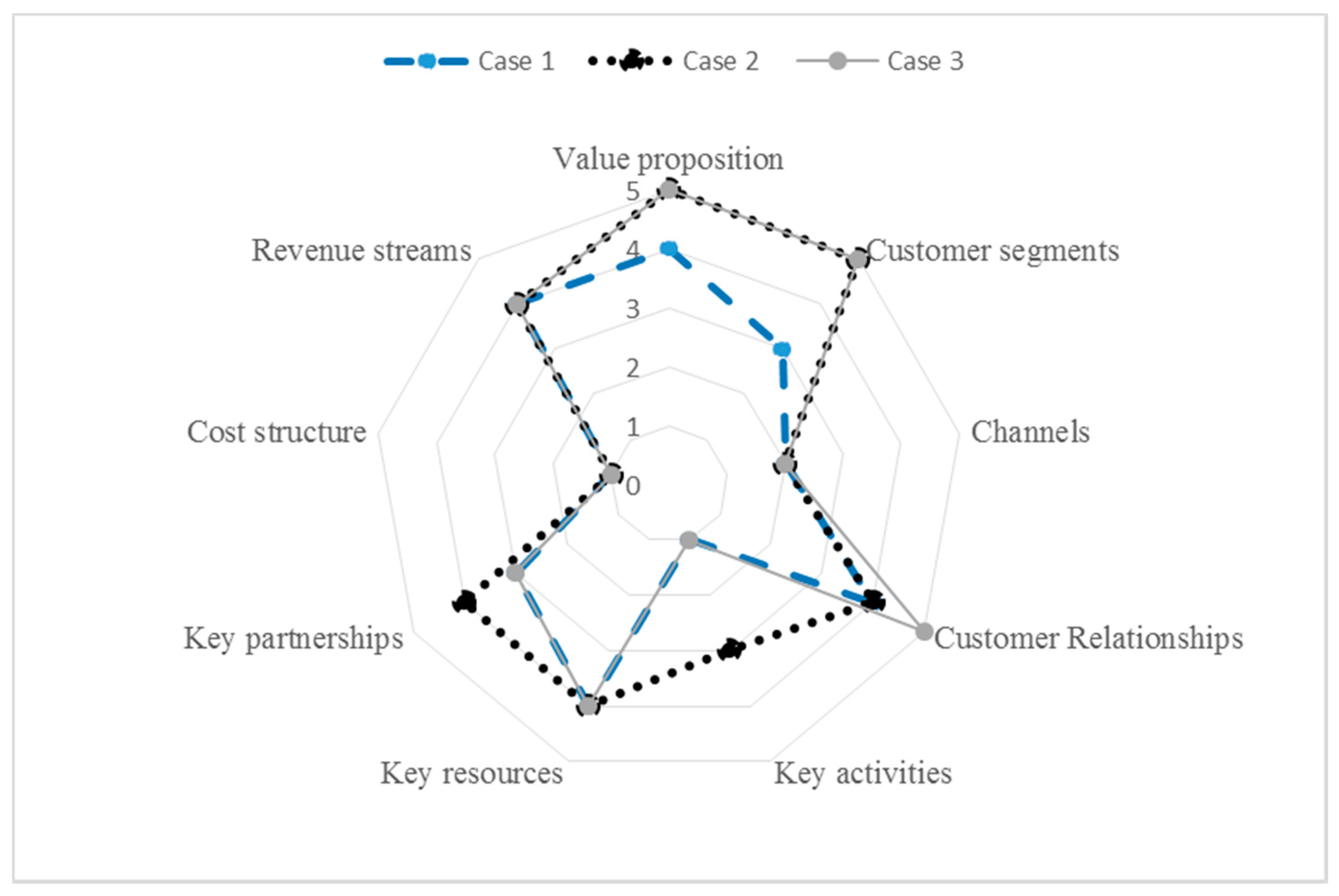
| Authors | Business Model Components |
|---|---|
| Morris et al. (2006) [1] |
|
| Johnson et al. (2008) [13] |
|
| Shi and Manning (2009) [14] |
|
| Barringer and Ireland (2010) [10] |
|
| Wirtz et al. (2016) [5] |
|
| Osterwalder and Pigneur (2014) [2] |
|
| Case 1 | Case 2 | Case 3 | |
|---|---|---|---|
| Position | Founder/manager | Founder/manager | Founder/manager |
| Education | Higher education (Business) | Higher education (Mathematics) | Higher education (Business) |
| Age | 63 | 47 | 41 |
| Prior experience | Software developer | Computer science teacher, software developer | Co-owner of web design company, freelancer |
| Founding year | 1990 | 2003 | 2008 |
| Employees (2018) | 45 | 50 | 47 |
| Net profit (2018) | 3,304,800 | 11,557,200 | 2,380,900 |
| Components of Business Model Canvas | Scale of Characteristics | ||||
|---|---|---|---|---|---|
| Low (1) | Middle (2–4) | High (5) | |||
| VP-Value Propositions | Standardized | Professional | Semi-customized | Customized | Fully customized |
| CS-Customer Segments | Local | Regional | National | International customers in Croatia | International customers abroad |
| CH-Channels | Direct sale channel | Web sales | One intermediary | Partners and intermediary | Two or more intermediaries |
| CR-Customer Relationships | Depersonalized | Automated | Semi-personalized | Personalized | Distinctively personalized |
| KA-Key Activities | Distinctive activity in narrow domain | Few distinctive activities | Integrate broad scope of distinctive activities | ||
| KR-Key resources | Financial | Physical | Human | Intellectual | Organizational |
| KP-Key partnerships | Occasional subcontractors | Few contractual partners | Long-term partners | Formalized and unformalized agreements | Complex set or arrangements, open network |
| CS-Cost structure | Fixed costs driven | Variable cost driven | Economics of scale | Economies of scope | ‘Creative design process’ and value driven |
| RS-Revenue streams | Transactional service sale | + “pay per use/renting” | + fee, in advance, premium access | + after sale service or complementary products | +third party supported (bonus, bartering) |
Publisher’s Note: MDPI stays neutral with regard to jurisdictional claims in published maps and institutional affiliations. |
© 2020 by the authors. Licensee MDPI, Basel, Switzerland. This article is an open access article distributed under the terms and conditions of the Creative Commons Attribution (CC BY) license (http://creativecommons.org/licenses/by/4.0/).
Share and Cite
Koprivnjak, T.; Oberman Peterka, S. Business Model as a Base for Building Firms’ Competitiveness. Sustainability 2020, 12, 9278. https://doi.org/10.3390/su12219278
Koprivnjak T, Oberman Peterka S. Business Model as a Base for Building Firms’ Competitiveness. Sustainability. 2020; 12(21):9278. https://doi.org/10.3390/su12219278
Chicago/Turabian StyleKoprivnjak, Tihana, and Sunčica Oberman Peterka. 2020. "Business Model as a Base for Building Firms’ Competitiveness" Sustainability 12, no. 21: 9278. https://doi.org/10.3390/su12219278
APA StyleKoprivnjak, T., & Oberman Peterka, S. (2020). Business Model as a Base for Building Firms’ Competitiveness. Sustainability, 12(21), 9278. https://doi.org/10.3390/su12219278





